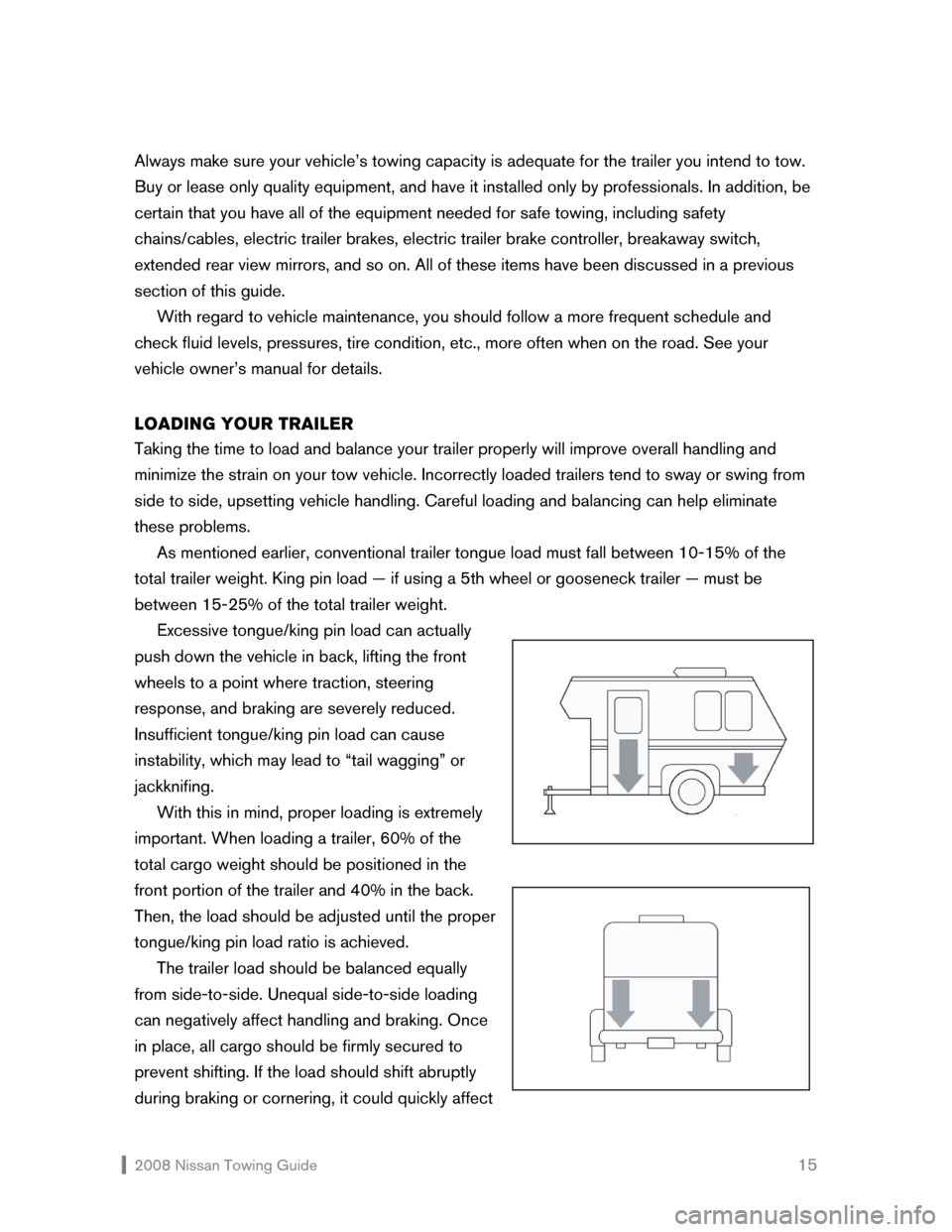rear view mirror NISSAN XTERRA 2008 N50 / 2.G Towing Guide
[x] Cancel search | Manufacturer: NISSAN, Model Year: 2008, Model line: XTERRA, Model: NISSAN XTERRA 2008 N50 / 2.GPages: 32, PDF Size: 1.16 MB
Page 9 of 32

2008 Nissan Towing Guide 8 to the bumper and chains/cables when making a sharp turn, do not attach the chains/cables
too close to the coupler. Consult your trailer manufacturer for the proper location of the
chain/cable attachment to the trailer.
REAR VIEW MIRRORS
In many cases, a trailer can block your rear vision when you’re using only the standard Nissan
rear view mirrors. These mirrors were not designed for towing. “Extended” mirrors specifically
designed for trailer towing should be used when your rearward vision is obstructed. Before
using these mirrors, make certain that they comply with state and local regulations.
Telescoping Tow Mirrors are available as an accessory for Armada and Titan vehicles. Contact
your Nissan dealer for details.
BREAKAWAY SWITCH
On a trailer with electric brakes, a breakaway switch can automatically activate the trailer
brake system if the trailer becomes separated from the tow vehicle. Should the trailer become
detached, a breakaway switch may help prevent the trailer from wandering into another lane
and will bring it to a safer stop with less damage.
A breakaway switch relies on the power of a trailer battery, so make sure it is not
discharged.
Never use the breakaway switch to “park” the trailer on a grade. The battery would
eventually discharge and release the brake, allowing the trailer to roll.
Be sure to leave enough slack in the tether on the breakaway switch to turn corners
without binding. If you do not, the electric trailer brakes will lock-up and not release. See your
trailer manufacturer for proper installation of a breakaway switch that is compatible with your
trailer braking system.
TRAILER LIGHTS
Trailer lights should comply with all applicable federal, state, and local regulations, and should
be in proper working order at all times. A trailer’s taillights, stoplights, and turn signals must be
wired* into the tow vehicle’s electrical system. Many trailers use the same filament of a dual-
filament bulb for both stoplights and turn signals. The second filament is used for the trailer’s
taillights. All Nissan vehicles utilize separate filaments for each function. Direct splicing of this
type of trailer lighting may cause damage to your vehicle’s electrical system and malfunction of
the trailer lighting. When connecting your Nissan vehicle to this type of trailer lighting system,
*See the SPECIFICATIONS section of this guide for wiring harness information specific to your
vehicle.
Page 16 of 32

2008 Nissan Towing Guide 15 Always make sure your vehicle’s towing capacity is adequate for the trailer you intend to tow.
Buy or lease only quality equipment, and have it installed only by professionals. In addition, be
certain that you have all of the equipment needed for safe towing, including safety
chains/cables, electric trailer brakes, electric trailer brake controller, breakaway switch,
extended rear view mirrors, and so on. All of these items have been discussed in a previous
section of this guide.
With regard to vehicle maintenance, you should follow a more frequent schedule and
check fluid levels, pressures, tire condition, etc., more often when on the road. See your
vehicle owner’s manual for details.
LOADING YOUR TRAILER
Taking the time to load and balance your trailer properly will improve overall handling and
minimize the strain on your tow vehicle. Incorrectly loaded trailers tend to sway or swing from
side to side, upsetting vehicle handling. Careful loading and balancing can help eliminate
these problems.
As mentioned earlier, conventional trailer tongue load must fall between 10-15% of the
total trailer weight. King pin load — if using a 5th wheel or gooseneck trailer — must be
between 15-25% of the total trailer weight.
Excessive tongue/king pin load can actually
push down the vehicle in back, lifting the front
wheels to a point where traction, steering
response, and braking are severely reduced.
Insufficient tongue/king pin load can cause
instability, which may lead to “tail wagging” or
jackknifing.
With this in mind, proper loading is extremely
important. When loading a trailer, 60% of the
total cargo weight should be positioned in the
front portion of the trailer and 40% in the back.
Then, the load should be adjusted until the proper
tongue/king pin load ratio is achieved.
The trailer load should be balanced equally
from side-to-side. Unequal side-to-side loading
can negatively affect handling and braking. Once
in place, all cargo should be firmly secured to
prevent shifting. If the load should shift abruptly
during braking or cornering, it could quickly affect